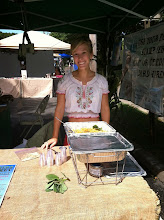The first signs of spring lead many to the salon where
toenails are primed and prepped for flip-flops and freed from the cobwebs of
winter’s wool socks. For others the warmth means dirt will finally find its way
back under overly pristine finger nails. Whether covered in soil or sparkles,
to market to market our hands will go where they once again grasp the delicate
fuzz of a tree-ripened peach or wooden handle of a ho.
Farmers wait all year for that moment when they can once
again get their hands dirty and start planting. Exactly when to plant seeds or seedlings is a
debatable subject that depends very much on who’s doing the planting. Seed
packet instructions dictate “after the last frost” while seasoned farmers wait
until “the ground thaws.” Choosing the right moment can be stressful for the
experienced farmer and home gardener alike.
But it’s not just the farmers who can’t wait to dive into
the dirt. Locavores-- a person whose diet consists primarily of locally
produced food-- have also endured the punishingly limited winter spread,
patiently awaiting the first blush glimpse of a perfectly ripened, plush pint
of strawberries. Just the sight of one more bunch of kale or jar of tomatoes rattles
up my palates’ cabin fever.
The return of farmers markets means an escape from last
year’s canned leftovers. While a bright jar of raspberry jam can surely satisfy
fruit cravings throughout desolate New York winters, 8 months without the fresh
juice of a ruby watermelon is simply far too long. Luckily, prized crops like
asparagus and peas successfully curb our appetites until summer. But this year’s summer treats seem light-years
away.
Farmers can put in buckets of effort to grow flawless
seedlings and prepare the most nutritious and fluffy soil, but they still can’t
predict or control the madness of spring weather. 2014 has been a bit of a
tease, beginning with 85-degree days in April to the current 45-degree nights
of June. This cold and confused weather stirs impatience in farmers and
locavores alike, as the cold spring not only delays the markets’ blossoming,
but also that of the plants.
Teddy Bolkas of Thera Farms in Ronkonkoma attributes this
year’s crops’ late maturation to the chilly spring. “They say you don’t have to
go to Vegas to gamble. Just become a farmer because you just don’t know what’s
going to happen,” he jokes, two weeks into June with not so much as the hint of
a tomato in sight. Though Long Island doesn’t
have to deal with late frosts that can be fixed by covering the plants to trap
heat, the cold weather has still taken its toll in the form of blossom drop.
Teddy described blossom drop as, well, dropping blossoms.
Tomatoes, zucchini, eggplant, and most peoples’ favorite summer crops start as
flowers that must be pollinated in order to develop into fruit. With cold
nights and limited sunlight during recent cloudy days, plant growth and
pollination have been limited. If the flowers are not pollinated within a week
of blooming, they drop off the plant and that fruit is lost. The pollinating bugs
don’t like the chilliness anymore than us. Teddy already lost about 50% of his
first set of flowers, which means 50% of his first harvest.
While kale, lettuce, spinach and other leafy greens that
don’t rely on pollinators are safe, everyone is still anxious to sink their
teeth into a succulent cucumber and impatience brews among farmers. Farmers
often start planting in greenhouses as early as March so harvests can begin by
mid to late June. “We’re 3-4 weeks back from where we should be,” says Teddy who
expects his first tomatoes the first week of July with peppers and eggplant due
2-3 weeks later. Much backbreaking time and effort went into getting those
plants planted on time for an early harvest. Not this year.
Ever the resourceful farmer, Teddy has a solution. Long
Island’s tomato whisperer wanted his loyal “marketophiles” to have their
tomatoes so badly that he spent days between tomato rows with a pollinator
wand, pollinating by hand to avoid losing another row of flowers that otherwise
would not make it to fruit. The wand vibrates the plants at the same frequency
as bumble bees (the main pollinator of tomatoes), shaking the pollen into a
cup. Teddy then distributes the pollen by hand onto the exposed stamen of the
flowers so they have a chance at becoming a fruit.
As much as we try to manipulate the land, we are constantly
reminded that our control is limited. Thank your farmer at your next market
visit. They might have been stuck in a field all day playing bumblebee, covered
in pollen! Be patient, locavores, as the farmers literally wave their magic
wands to get us the prized succulent fruits of summer. We’ve all heard it
before: absence makes the heart grow fonder and no fonder can it be than of the
first, luscious bite of a market fresh tomato.
"Baby" tomatoes in early summer. Every tomato started like the yellow flower in the photo.
Teddy and his father, early summer at Thera Farms.
This article appeared in the newsletter for LIGreenmarket, a farmers market organization run by Bernadette Martin.



No comments:
Post a Comment